Parking the car whether parallel parking or parking in a bay can for some, be a near impossible task. In this article on how to park, we will offer some tips and help with reference points for these manoeuvres, making parking a little less difficult and stressful.
How to park a car by Parallel parking
Let’s start with the parallel parking technique on how to park. The diagrams below will give you a clear example on how to do this.
Parallel parking or reverse parking as it is sometimes referred to is a manoeuvre where you will be required to reverse and stop between two vehicles parked at the side of the road.
Some struggle with parallel parking, but all it takes is to set yourself up with 2 or 3 reference points and away you go.
A good idea may be to practice this technique on a quiet road a couple of times just to get used to it as on occasions you may need to parallel park on a busy road.
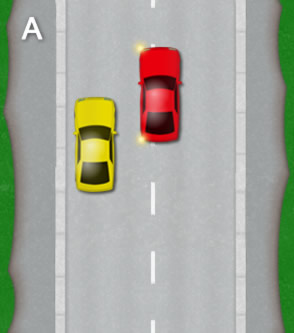
Parallel parking diagram A
How to park a car – parallel parking diagram A
Whilst driving along looking for somewhere to park, if there are plenty of other cars parked up, you may need to consider a parallel park. If the road is busy, keep a good check on your rear mirror because when you locate an ideal spot, you will need to signal to the left to let other vehicles you are slowing down. They may think you are taking a left turn when in fact you will be stopping, so slow down gradually if possible to give the car behind time to react.
Stop alongside the vehicle you wish to park behind. An ideal distance is around 1 meter from door to door. Once stopped, select reverse gear and ensure it is safe and no pedestrians are crossing and the vehicle behind has left enough room for you to reverse.
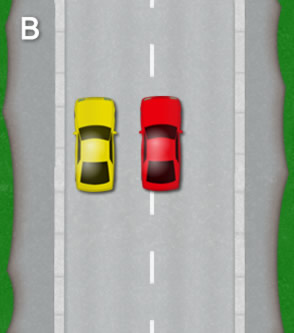
Parallel parking diagram B
How to park a car – parallel parking diagram B
When safe, begin to reverse until the cars are level at the rear. To establish where this is, if for example your car and the car to your left are a similar size, line the side mirrors up. Another reference point is to get the very rear of the car to your left in about the centre of your rear left window, or the front of the car to your left, depending which way round it is.
These reference points may need to be altered slightly depending on what car you have. Again, have a practice go on a quiet road to establish this. Once you are happy that the cars are around level at the back, it may be an idea to stop.
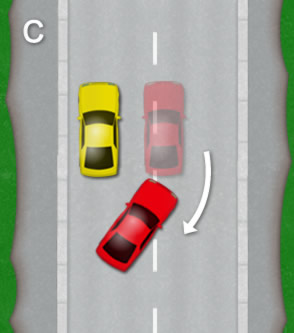
Parallel parking diagram C
How to park a car – parallel parking diagram C
You will need to now steer one complete turn of the wheel to the left. You can turn full left lock but this may potentially leave the front of your car too close to the rear of the car in front as the turning angle will be harsher. Before you do this however, take a quick look to your right blinds pot in case there are any cyclists or pedestrians there. The front of your car will swing out into the road so it is potentially hazardous.
Once you are happy it is safe, are slowly and have turned the wheel one complete turn to the left, you will now need to establish another reference point. There are 2 reference points that can help. When the left front corner of your car lines up with the rear right corner of the car in front you can then steer full lock right.
Also by looking in your left mirror, you will notice as you are reversing, a triangle between your car and the curb. This triangle as you reverse gets smaller, when the triangle is completely gone, it is time to steer right full lock. Ensure when steering right you have sufficient clearance from the car in front.
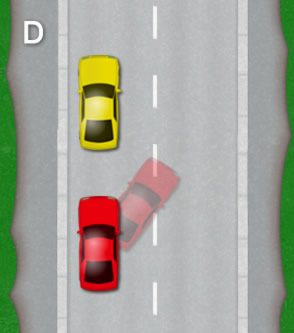
Parallel parking diagram D
How to park a car – parallel parking diagram D
As the car straightens up, steer one turn of the wheel to the left to straightened the wheels up. To establish when the car is straight, you should notice in your left mirror that the curb is running down the road parallel to your car.
Using these reference points should keep you a good parking distance from the curb. If you feel you are still too far in the road, move forward slightly and reverse again steering to the left and right again to straighten up.
Ensure you don’t park too close to the car in front. If a vehicle parks very close behind you whilst you are gone, you may have trouble getting out.
How to park a car by Bay parking
Bay parking is a manoeuvre you might need to do at a supermarket for example. On many occasions it can simply be easier to park in a bay by driving forward into it. You do however need to think how easy it is to then reverse out again.
If the parking bays and the road is a little on the narrow side, you may find it easier to reverse in and drive our forward later. Provided here is an example of how you may want to try reverse bay parking. It doesn’t have to be exactly like this and with practice, you will get proficient so as not to have to use reference points.
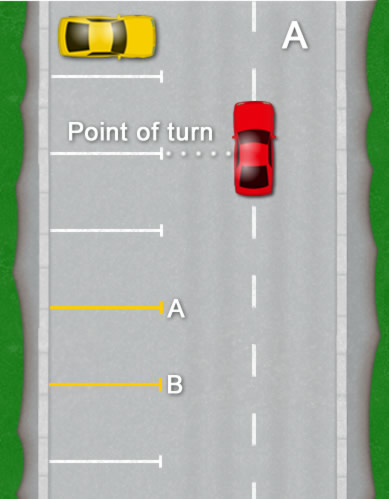
Bay parking diagram A
How to park a car – bay parking diagram A
Whilst driving looking for that all important free space, keep a check in your rear mirror as you may need to signal to the left to let any vehicles behind you that you intend to stop. When you stop the car, stop with around an equal distance from the cars on the left and from what is on the right. This will give you adequate turning angle into the bay and plenty of distance to the right for when your car swings out.
Stop with the third line lined up with the centre of your passenger front door as illustrated in the diagram. This reference point may have to be altered slightly depending on your car. Try and find a quiet area to practice if you feel your reference points need altering.
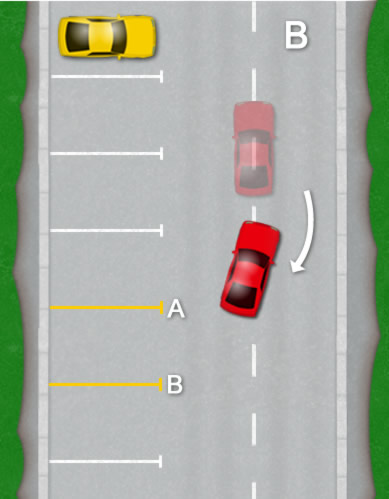
Bay parking diagram B
How to park a car – bay parking diagram B
Once in position, select reverse gear. Before you start to move backwards, take a good look around as there may be pedestrians. Also take a look in your right blind spot as the front of your car is now going to swing out to the right and there may be a cyclist.
Once all clear, start to move backwards and steer to full left lock. This will guide you into the third bay from the reference line. As you are reversing, keep checking initially your left mirror as you can start to see the left line (line B) of your bay appearing. If it is looking too close to the line, steer a little to the right.
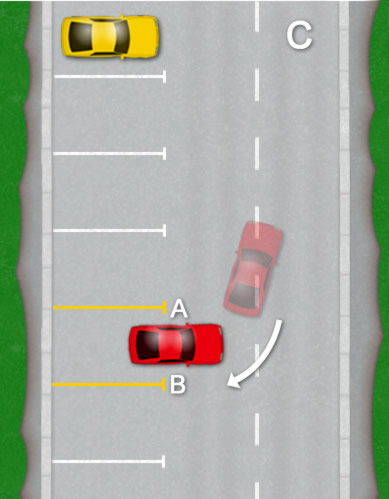
Bay parking diagram C
How to park a car – bay parking diagram C
As your car begins to straighten up, you should be able to see the right side line (line B) appearing in your right mirror. As you are slowly reversing, you can adjust accordingly.
Remember to keep the car slow and look around in all directions constantly. Where bay parking is located, there is likely to be pedestrians and other vehicles.
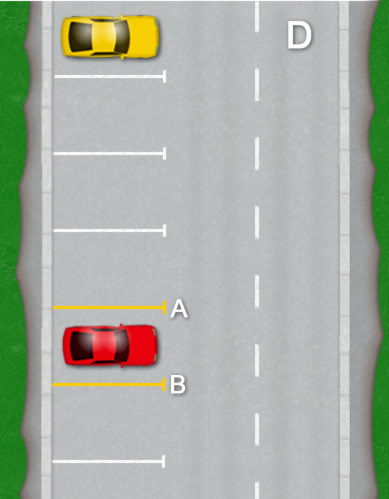
Bay parking diagram D
How to park a car – bay parking diagram D
Remember, which ever line you need to get closer to for any adjustment, steer towards that line.
As a final reference point if needed, line the start of the right side bay line up with your right mirror as you are reversing. This should give you a good indication of when to stop reversing. If the bonnet of your car is rather long, you may need to allow this reference point to go a little further to go back a little more.
How to park a car tips
Below are some tips on how to make parking your car an easy task.
-
Speed
Try and keep the car very slow. If you can imagine a slow walking pace, this would be an ideal speed. By keeping the car at this speed, it will allow you to be more accurate with your reference points and to look around more often.
-
Observation
These parking manoeuvre involve reversing, making it difficult to see. Keep looking around constantly 360 degrees. Children and cyclists tend to come out of nowhere very quickly.
-
Approaching vehicles and pedestrians
It may be appropriate to stop if a vehicle is approaching, just so you can get an idea what they plan on doing. If it looks like they are going to wait and let you continue, then proceed. If it looks like they want to get round, it may be a good idea to let them get out of the way before continuing.
-
Practice
These manoeuvres can be stressful when you are not very confident in your ability, especially if there is other vehicles waiting. If possible, find a quiet location where you can spend a little time to practice how to park. You should find that this will build your confidence.
-
Your seat belt
You may possibly find that when reversing, your seat belt restricts you from looking around efficiently. It is legal to remove your seat belt whilst reversing for this very reason.
-
Additional mirrors
Having additional mirrors fitted to your side mirrors are not only inexpensive, but also can aid in safety as they allow you so see areas that your standard side mirrors can’t always see. If you struggle with parking, either parallel or bay parking, these mirrors can also benefit you in terms of understanding distances of such obstacles as curbs and bay lines.
-
When to stop
It can be a little difficult to know when to stop whilst reversing. Use the tip in diagram D for bay parking, for parallel parking, you can see the cars head lights in your rear view mirror. Providing you can see them whilst reversing, you are not going to hit the car behind. As the cars head lights just disappear from your rear view mirror, you will still have a good metre or so distance from them. This is only a rough estimate and of course does not apply to large or taller vehicles that you are reversing towards.

Is it a good idea to leave a car parked in gear even when not on a hill, rather than neutral?
Hello Matt,
As extra security against the failure of the parking brake, leaving your car parked in gear when not on a hill can be a good idea. However, if a car is relatively new and well maintained, it would be highly unlikely for any issues to occur on a level surface.
Is it still best to use the parking brake as well as the gear. I’ve heard you can leave the parking brake off to stop it ‘sticking’
Thanks. What is the best gear to leave in n a level surface. Are either first or reverse fine?
Hello Matt,
On a level surface, first gear will be fine.
I read your article with a lot of attention and I found it useful in addition to its content. Do not stop caring this web is good.
regards